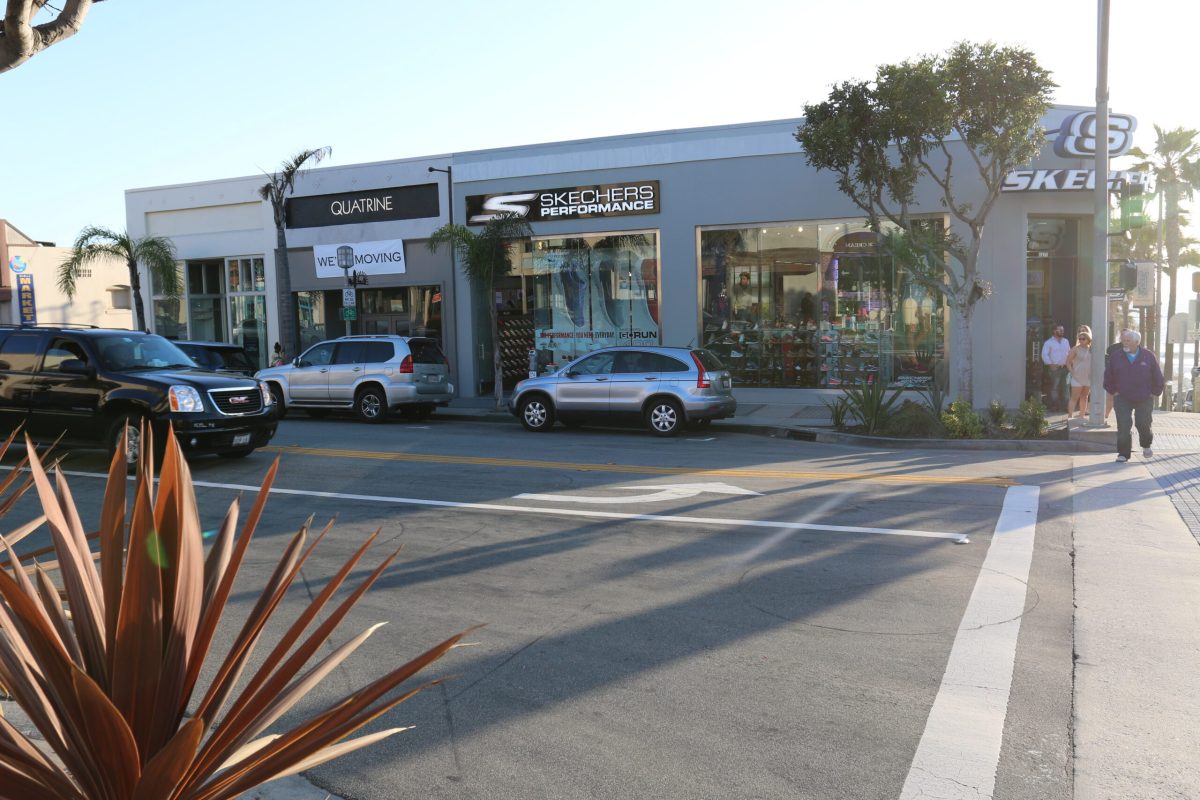
Skechers has received tentative approval to expand its flagship retail store in downtown Manhattan Beach, prompting concern from residents about the effectiveness of the recently approved Downtown Specific Plan before it has even been implemented.
The Planning Commission’s decision Wednesday allows the store at the intersection of Manhattan Avenue and Manhattan Beach Boulevard to expand into a now-vacant property, a former furniture store, immediately to the south. (Another vacant parcel, the former home of Lucky Brand Jeans, also sits on the block, but is not part of the proposal.) The project will appear on agenda for the City Council meeting on April 18, which is also the last day to file an appeal of the project.
The commission’s approval of the project comes less than five months after the City Council approved the Downtown Specific Plan, a master zoning document intended to preserve the neighborhood’s small-town, beach charm. The plan was passed in response to office uses rapidly filling ground-floor storefronts that once housed retail or restaurants, a change many feared could sap the neighborhood’s social energy.
Although only eight residents spoke out to the Planning Commission about the proposal, they tilted heavily toward opposition, saying that the project threatened the character of the area. And they worried that request that came from Skechers, the second-largest shoe manufacturer in the country and arguably the city’s most prominent business, sent the wrong message about the strength of the protections the plan offered.
“[The Specific Plan] is being tested right out of the gate. This is a great opportunity, because Skechers is obviously a very prominent citizen of this town. And valued. So this puts the issue squarely before you: are you willing to enforce the law against everyone?” resident George Kaufman told commissioners.
The Skechers proposal exceeds the Specific Plan’s guidelines for sales-floor area and frontage transparency. But the plan does not prohibit things like banks, mega-stores or chains in the downtown. Instead, it requires the applicants with such projects to obtain a Conditional Use Permit from the Planning Commission. In order to issue such a permit, the commission has to make several findings that were crafted to capture the spirit of the concerns that motivated the plan. These include that the proposed use is “in accord with the purposes of the district” and would “preserve and enhance” the neighborhood’s small town feel.
At Wednesday’s meeting, commissioners unanimously endorsed the recommendation of city planning staff to approve the permit. They cited several accommodations Skechers had offered to make, and noted that if the commission did not approve the permit, Skechers could still open an outlet in the adjacent location, which it already controls. Though the two would not be connected in that scenario, going through the use permit process gives the commission more of a voice in shaping the project.
“They can still put the store in, and then we don’t get control,” Commissioner Chris Conaway said.
This reasoning appeared unlikely to assuage the project’s opponents. Carol Perrin, head of the Downtown Residents’ Group, was intimately involved in crafting the Specific Plan. At Wednesday night’s meeting, she told commissioners that the store’s “big-box look” clashed with the values the plan had enshrined.
“To make it one big store is just inconsistent with the goal of our community,” Perrin said.
Skechers executives tried to reassure residents that the proposal would not negatively affect street life. Project engineers downplayed the scale of the project, characterizing the linking of the stores as a “pass through” from one to the other. They also pointed to frontage improvements slated for the Manhattan Avenue side of the store that would differentiate parts of the building’s exterior.
“From the street, it will appear as three separate store fronts,” said Tim Ball, vice president for commercial development for Skechers. “The last thing we want to do is take away from that small-town feel.”
The expanded store is symbolically important for Skechers because it was the first retail location the company ever established. The larger store will better allow the company to display its transition from a shoe company to a “lifestyle brand,” featuring clothing and other apparel.
Because it is awaiting approval by the California Coastal Commission, the Downtown Specific Plan is technically not in force. Instead, an interim zoning ordinance, which the city passed to prevent further degradation of the downtown while the plan was being crafted, governed the issue. Nonetheless, city staff asked the Skechers developer for additional information to examine compliance with the plan, and commissioners frequently referenced the plan in their discussions.
The interim ordinance and the plan share many similarities. But they differ in one critical respect for the Skechers proposal. The interim zoning ordinance regulates “buildable floor area,” while the Specific Plan focuses on “sales-floor area.” The Skechers store exceeds the requirements set out under either document, but because a significant portion of the new Skechers store will be devoted to storage, it hews far closer to the sales-floor area measurement of the Specific Plan. The new store calls for 4,829 square feet of total floor area, but only 2,183 square feet of sales space. The limit under both plans is 1,600 square feet.
The new project will meet or exceed transparency requirements, which encourage large windows to enhance street life, on Manhattan Avenue, though not along Manhattan Beach Boulevard. Now and under proposed plans, a narrow rectangular window covers a considerably smaller proportion of the north-facing edge of the building; this, staff said, is due to the engineering challenges associated with the sharp downward slope of the street.
The site currently has a large gray wall on the Manhattan Beach Boulevard side. Both this and the blank space on the middle of the Manhattan Avenue side will display works from local artists, Ball said. Commissioners voted to leave the selection of artwork to the city’s Cultural Arts Commission.
Ball also highlighted the company’s considerable local charitable giving. Since 2008, he said, the Skechers Pier to Pier Friendship Walk has raised $7.1 million; last year’s event drew more than 12,000 people and raised $1.6 million for area education foundations and children with special needs.
But the reference to the company’s generosity may have backfired, as both residents and, initially, a commissioner, suggested that Skechers’ prominent place in the town made city staff more inclined to look favorably on the proposal.
“It feels like staff is jumping through all kinds of hoops to get to yes,” Vice Chair Steve Ortmann said.
Planning staff rejected the idea that they based their decision on anything other than the project attributes, and Ortmann later apologized for the suggestion. But, attempting to reconcile approval with the bitter opposition of residents involved with putting the Specific Plan together, the commissioners stumbled on perhaps an even more sensitive idea: that the Specific Plan’s protections were not as hard and fast as some had hoped.
At Wednesday night’s meeting, resident Neil Leventhal described the effect of approving projects like Skechers through the use permit process as “death by 1,000 variances.” And while the Specific Plan does set some categorical limits, like a prohibition on service stations in downtown, staff emphasized that it leaves ample room for variation. The sales-floor area figure, staff said, was based on a sample of existing neighborhood stores, but was not intended to be an absolute.
“The community, City Council, Planning Commission did set that 1,600-square-foot cap, but they also gave the opportunity for deviation from that through the use permit. They never said, ‘Nope 1600, no way to wiggle past that,’” said Assistant Planner Ted Faturos.
But it is not clear how well that distinction was absorbed. In the run up to the plan’s approval, many residents expressed hope that the document would fix a planning process that did not offer residents adequate protection from projects, and forced them to be eternally vigilant about proposed projects.
“All of these things have gotten through with laws in place. Exceptions, variances, use permit processes and all of these other things don’t control the mysterious ways businesses have to wrangle out of these rules,” said resident Kenneth Thompson, the night the council approved the plan.











